Exponential Technology
This 5 post series addresses as to how “we are facing exponential threats from resource crunch and environmental degradation and that in response, we are inventing a new idea age”.
- Exponential Threats identifies the exponentially growing threats we are presently facing
- This post, Exponential Technology, argues that our exponentially growing technology, our best ally, is not sufficient to tackle these threats. To do that, unprecedented level of human ingenuity should come into play.
- In Origin of Ideas, we discuss the source of human ingenuity, both inside an individual’s head and across the society.
- In Age of Creativity, we address as to why we have reasons to believe that we are entering an era of unprecedented global creativity.
- In the last post, we will address as to how you can prepare for the coming Idea Age
Exponential Technology
One ray of hope against this exponential threat is one proven exponentially growing tool available with us: Our technology, at least the Information Technology. A group of people are such staunch believers in the power of exponential technology that they even predict that human beings would demat (de-materialize, become digital) by 2045! 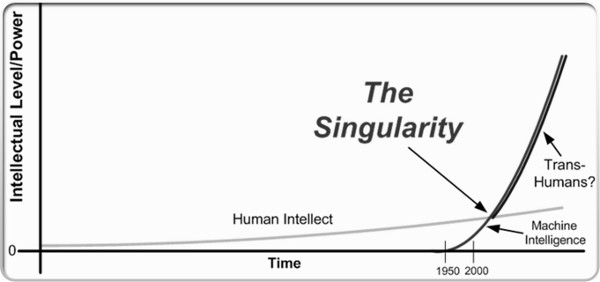 In a world where human beings are demated (i.e. our minds are ported into machine), we don’t need agriculture, we don’t need cooking, we don’t need transportation (we will travel on electrons), we don’t need to die, we don’t need to have children, we all can have zillion clones, each one of them living inside a $1000 computer! The world inhabited by demat human beings will use less resources than anyone in 20th century could have imagined. This merger of man with machine was named the Technological Singularity (or, simply, Singularity) by the man who predicted it. It is, of course, so loony and so outlandish an idea no on in their right mind would even dare mentioning it in a civil conversation. Only problem is that this idea has been put forward by a no-nonsense person, backed by solid data with mind boggling predictive power.
In a world where human beings are demated (i.e. our minds are ported into machine), we don’t need agriculture, we don’t need cooking, we don’t need transportation (we will travel on electrons), we don’t need to die, we don’t need to have children, we all can have zillion clones, each one of them living inside a $1000 computer! The world inhabited by demat human beings will use less resources than anyone in 20th century could have imagined. This merger of man with machine was named the Technological Singularity (or, simply, Singularity) by the man who predicted it. It is, of course, so loony and so outlandish an idea no on in their right mind would even dare mentioning it in a civil conversation. Only problem is that this idea has been put forward by a no-nonsense person, backed by solid data with mind boggling predictive power.
Exponential Intelligence
Ray Kurzweil, the proponent of Technological Singularity, took 15 different prominent lists, containing major intelligence events in the history of planet earth and plotted it on a log-log graph sheet. Here is what he got: 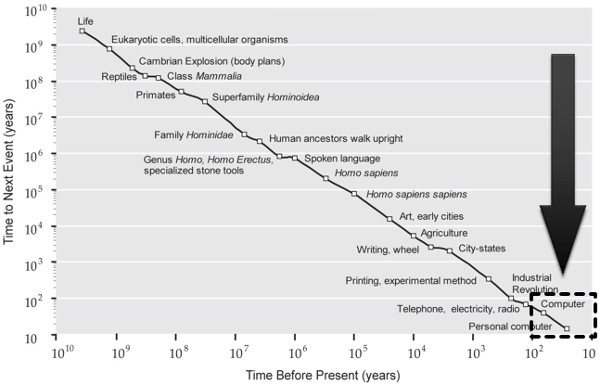 Kurzweil showed (see his book Singularity is Near) that the exponential growht of information technology during later past of 20th century, attributed to Moore’s Law, is merely a part of a larger trend that has been unfolding from the formation of Milkey Way Galaxy! The trend is so reliable and predictable that Kurzweil proposed that it could be safely extrapolated into the future.
Kurzweil showed (see his book Singularity is Near) that the exponential growht of information technology during later past of 20th century, attributed to Moore’s Law, is merely a part of a larger trend that has been unfolding from the formation of Milkey Way Galaxy! The trend is so reliable and predictable that Kurzweil proposed that it could be safely extrapolated into the future. 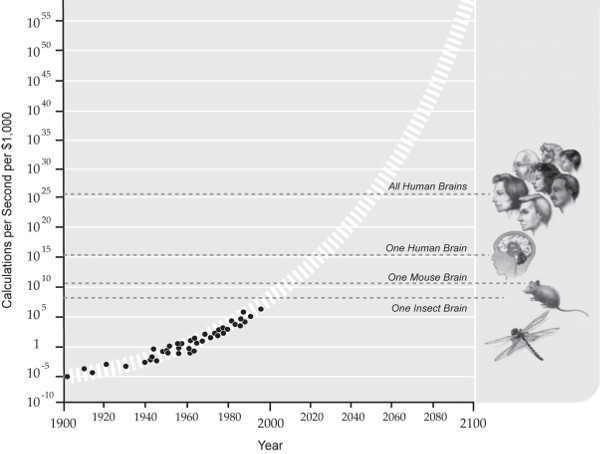 By extrapolating the trend, he showed that by 2013, our super computers would have enough processing power to enable human brain’s functional simulation
By extrapolating the trend, he showed that by 2013, our super computers would have enough processing power to enable human brain’s functional simulation
PS: Incidentally, in 2013, Kurzweil took up a job with Google and he now heads a project to build the human brain in a machine. In this 2014 TED talk, he discusses as to how intelligent machines that are capable of reading the entire internet will be here in less than 10 years.
He also showed that by 2025, the super-computers will have enough processing power to enable neural simulation of human brain! He went on to predict that by 2045, $1,000 would buy enough processing power to equate all the 10 billion human brains alive that year. By 2045, Kurzweil speculates, we will have the capabilities to port human brain into intelligent machines! However, there is a leap of faith that Kurzweil fails to address adequately. For example, by 2014, $1,000 can already buy more processing power than what is in a mouse brain.
But then, were are the cyborg mice?
While Kurzweil had provided wonderful argument to establish the predictable growth of computing power, he failed to show convincingly as to how the increase in processing power would result in augmentation of intelligence. Though, he provided some indirect evidences to his argument. Kurzweil showed that even stuff that doesn’t seem to be directly related to information technology explosion seem to follow the exponential curve.
Example 1: Exponential increase of private manufacturing in USA
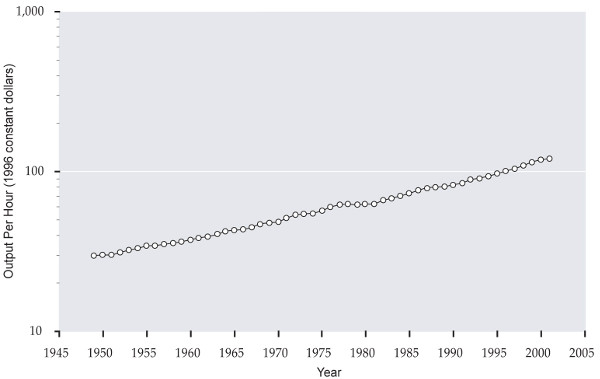 Example 2: Per-capita GDP of USA
Example 2: Per-capita GDP of USA 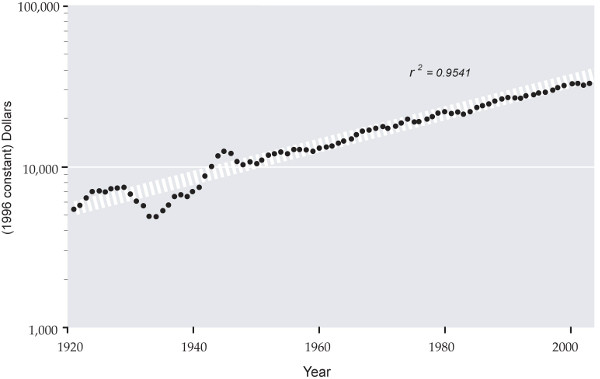 In other words, Ray Kurzweil showed that technology grows exponentially, that intelligence grows exponentially and that wealth creation happens exponentially. He failed to adequately explain the anomaly between the humongous processing power we have today and primitive state of current intelligent machines.
In other words, Ray Kurzweil showed that technology grows exponentially, that intelligence grows exponentially and that wealth creation happens exponentially. He failed to adequately explain the anomaly between the humongous processing power we have today and primitive state of current intelligent machines.
Idea Explosion
A thinker, author, journalist, politician and ex-banker called Matt Ridley came up with a plausible explanation for the puzzle that Kurzweil left unanswered. Unlike the data driven argument put across by Kurweil, Ridley’s explanation was just another leap of faith. Though, he made an elaborate anecdotal evidences and couched his argument in it. As we will see in the sequel to this post, Ridley argued that human ingenuity would rise to the occasion and save the day.
REFERENCES: - This post is sequel to Idea Age is Here: Part 1, Exponential Threat - Next post in this series is Origin of Ideas - All the posts in this series are based on the presentation Idea Age is Here - In this TED video recorded in 2005, Ray Kurzweil explains the 'impending' Technological Singularity
